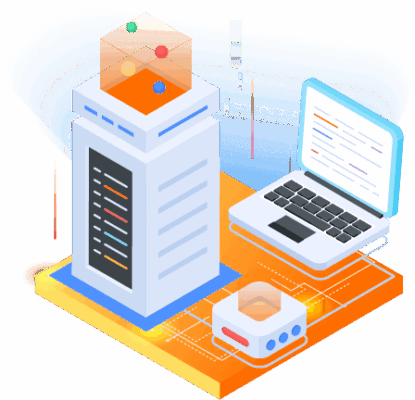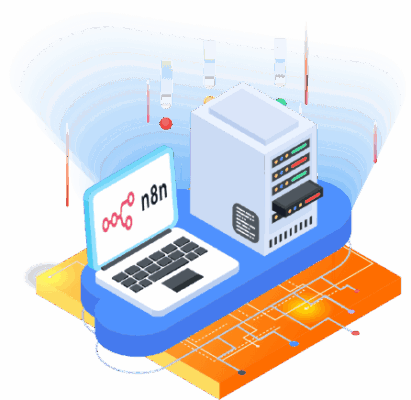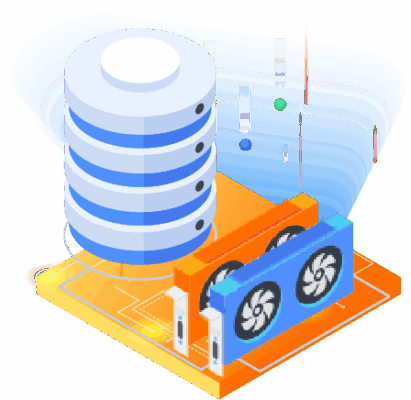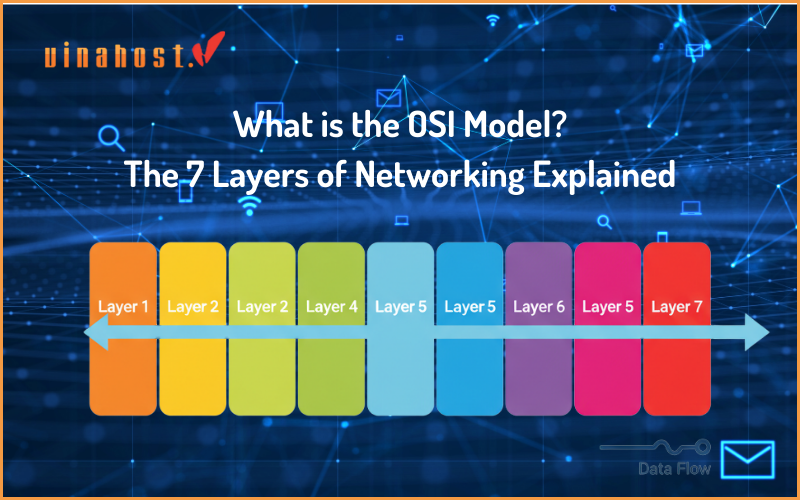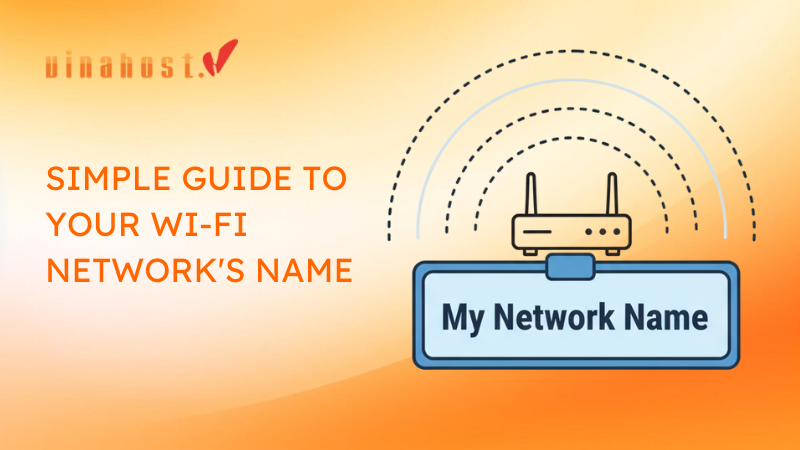What is a Cloud Server? A cloud server refers to a virtual server that runs on a cloud computing environment. Instead of being hosted on a single physical server, cloud servers are hosted on a network of interconnected physical servers provided by a cloud service provider. These servers can be accessed and managed remotely over the internet. Let’s find out through the following article of VinaHost.
1. What is a Cloud Server?
A cloud server is a virtualized server that runs on a cloud computing infrastructure. Instead of being hosted on a physical hardware system, a cloud server is hosted in a virtualized environment that can be easily scaled up or down based on demand.
Cloud servers are typically deployed, managed, and maintained by cloud service providers such as Amazon Web Services (AWS), Microsoft Azure, Google Cloud Platform (GCP), and others.
Cloud servers offer a flexible and cost-effective solution for hosting a wide range of applications and services, making them a popular choice for businesses of all sizes.
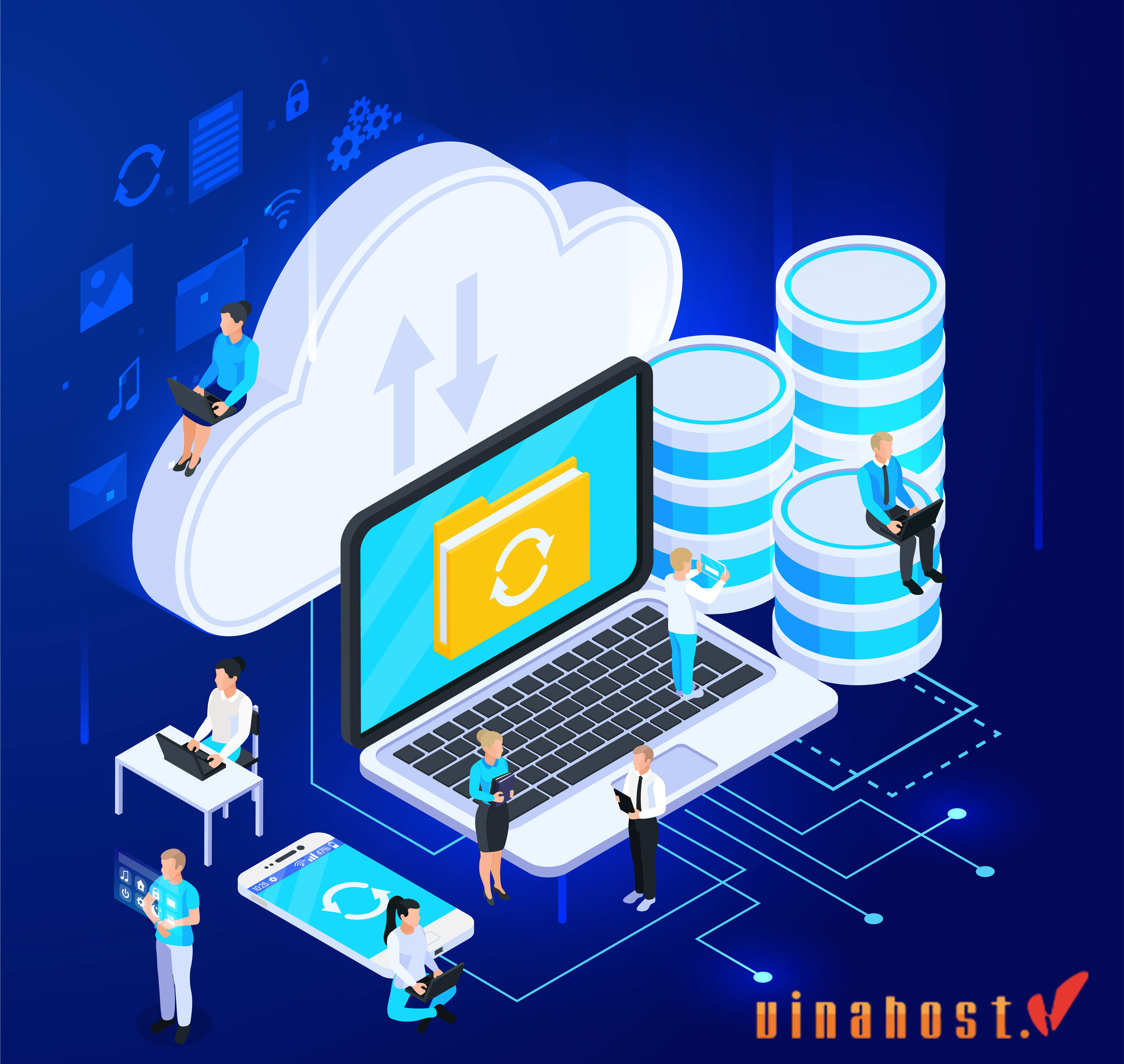
Also Read: What is a Server? Understanding the Backbone of Modern Technology
2. Importance of cloud servers in modern technology
Cloud servers play a crucial role in modern technology for several reasons:
- Scalability: One of the most significant advantages of cloud servers is their scalability. They allow businesses to easily scale resources up or down based on demand, ensuring that applications and services can handle fluctuations in traffic without any downtime or performance issues. This scalability is particularly important in today’s fast-paced digital environment, where the ability to rapidly respond to changing needs is essential for competitiveness.
- Flexibility: Cloud servers offer unparalleled flexibility in terms of deployment options, operating systems, and configurations. This flexibility enables businesses to tailor their infrastructure to meet specific requirements and easily adapt to evolving technology trends and customer demands. Whether deploying a simple website or a complex microservices architecture, cloud servers provide the flexibility needed to support diverse workloads and use cases.
- Reliability: Cloud servers are typically hosted in redundant data centers with high levels of availability and fault tolerance. This ensures that applications and services hosted on cloud servers are highly reliable and resilient to hardware failures or disasters. Additionally, cloud providers often offer service-level agreements (SLAs) guaranteeing uptime and performance, giving businesses peace of mind knowing that their infrastructure is backed by robust reliability measures.
- Cost-effectiveness: Cloud servers operate on a pay-as-you-go pricing model, where businesses only pay for the resources they consume. This cost-effectiveness eliminates the need for upfront capital investment in physical hardware and allows businesses to align their infrastructure expenses with actual usage. Moreover, cloud servers eliminate the costs associated with maintaining and managing on-premises hardware, such as electricity, cooling, and hardware maintenance.
- Global Reach: Cloud servers enable businesses to deploy their applications and services closer to their target audience by leveraging the cloud provider’s global network of data centers. This distributed infrastructure reduces latency and improves performance for end-users worldwide, leading to a better user experience. Additionally, cloud servers facilitate geographic redundancy, ensuring that businesses can maintain operations even in the event of regional outages or disruptions.
- Innovation: Cloud servers provide access to a vast ecosystem of cloud services, APIs, and development tools that enable businesses to innovate rapidly and deliver new features and functionalities to market faster. From artificial intelligence and machine learning to big data analytics and Internet of Things (IoT) platforms, cloud servers serve as the foundation for cutting-edge technological advancements and digital transformation initiatives.
Cloud servers are integral to modern technology infrastructure, empowering businesses to be more agile, efficient, and innovative in today’s digital landscape. Their scalability, flexibility, reliability, cost-effectiveness, global reach, and support for innovation make them indispensable for organizations seeking to thrive in an increasingly competitive and dynamic market.
Also Read: What is VPS? | Unveiling the Power Behind Virtual Private Servers
3. How Does a Cloud Server Work?
A cloud server works by leveraging virtualization technology to provide computing resources over the internet. Here’s a simplified explanation of how it works:
- Virtualization: Cloud servers operate within a virtualized environment. Virtualization technology enables the creation of multiple virtual instances of a physical server, known as virtual machines (VMs). Each VM behaves like an independent server with its own operating system, applications, and resources, but they all share the underlying hardware resources of the physical server.
- Cloud Infrastructure: Cloud servers are hosted on the infrastructure of cloud service providers, such as Amazon Web Services (AWS), Microsoft Azure, Google Cloud Platform (GCP), or other providers. These providers operate vast data centers equipped with servers, storage, networking equipment, and virtualization software to support the deployment and management of cloud servers.
- Resource Allocation: When a user or organization requires computing resources, they can provision cloud servers through the cloud provider’s management interface or APIs. They specify the desired amount of CPU, memory, storage, and other resources needed for their workload.
- Deployment: Upon request, the cloud provider’s infrastructure provisions the requested cloud server by allocating the necessary virtualized resources from the pool of available hardware. The virtual machine is then instantiated and configured based on the user’s specifications, including the choice of operating system and software stack.
- Access and Management: Once deployed, users can access and manage their cloud servers remotely over the internet using secure protocols such as SSH (Secure Shell) or Remote Desktop Protocol (RDP). They can install, configure, and manage software applications, data, and settings on the cloud server just as they would on a physical server.
- Scalability: One of the key advantages of cloud servers is their scalability. Users can easily scale up or down the resources allocated to their cloud servers based on changing demand. This scalability allows businesses to handle fluctuations in workload and traffic without the need for manual intervention or downtime.
- Redundancy and High Availability: Cloud providers typically offer redundancy and high availability features to ensure that cloud servers remain accessible and reliable. This may include automatic failover mechanisms, data replication across multiple data centers, and load balancing to distribute traffic evenly across multiple instances.
- Billing: Cloud servers are billed based on usage, typically following a pay-as-you-go or subscription-based pricing model. Users are charged for the resources they consume, such as compute hours, storage usage, data transfer, and additional services utilized.
A cloud server operates within a virtualized environment provided by a cloud service provider, allowing users to access and manage scalable computing resources over the internet. This model offers flexibility, scalability, reliability, and cost-effectiveness, making it an attractive option for businesses of all sizes.
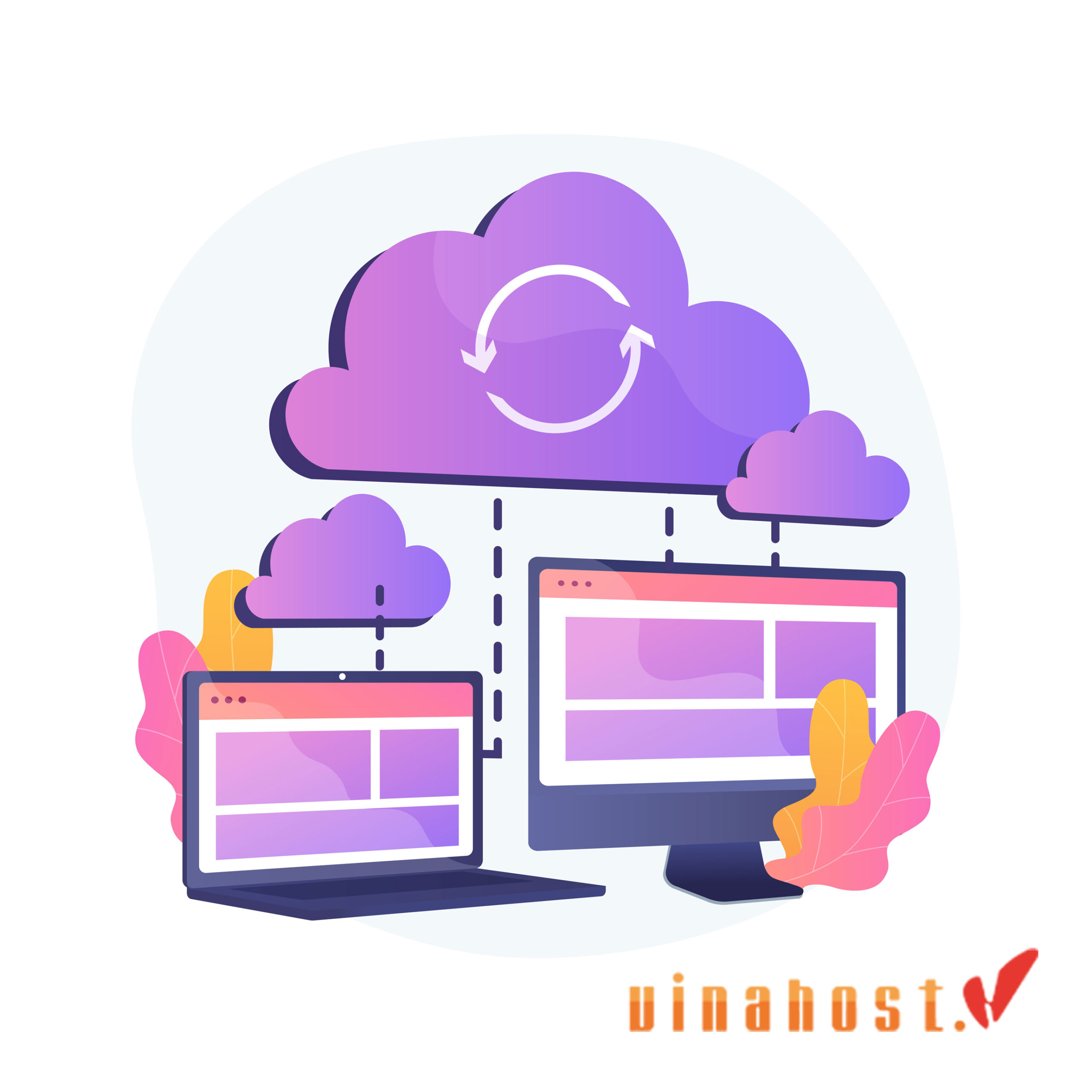
4. Types of Cloud Servers
4.1. Public cloud servers
Public cloud servers refer to cloud computing resources that are owned and operated by third-party cloud service providers and are made available to the general public over the internet. These servers are hosted in data centers managed by the cloud provider and are accessible to multiple users and organizations simultaneously. Here are some types of public cloud servers:
- Infrastructure as a Service (IaaS): In an IaaS model, cloud providers offer virtualized computing resources such as virtual machines (VMs), storage, and networking infrastructure over the internet. Users can provision and manage these resources on-demand, paying only for the resources they consume. Examples of public IaaS providers include Amazon Web Services (AWS) EC2, Microsoft Azure Virtual Machines, and Google Compute Engine.
- Platform as a Service (PaaS): PaaS providers offer a platform for developing, deploying, and managing applications without the complexity of infrastructure management. Public PaaS offerings typically include runtime environments, databases, development tools, and other services to support application development and deployment. Examples of public PaaS providers include Heroku, Microsoft Azure App Service, and Google App Engine.
- Software as a Service (SaaS): SaaS providers offer cloud-based software applications accessible over the internet on a subscription basis. Users can access and use the software through a web browser or application interface without needing to install or maintain any infrastructure or software components locally. Examples of public SaaS offerings include Salesforce, Microsoft Office 365, and Google Workspace.
- Compute Instances: Public cloud providers offer a wide range of compute instances with varying configurations to suit different workload requirements. These instances may include general-purpose, compute-optimized, memory-optimized, storage-optimized, and GPU-accelerated instances, among others. Users can choose the instance type that best fits their application’s needs and scale resources up or down as required.
- Storage Services: Public cloud providers offer various storage services, including object storage, block storage, and file storage, that users can leverage to store and manage data in the cloud. These storage services offer scalability, durability, and high availability, making them suitable for a wide range of use cases, from backup and archiving to content delivery and big data analytics.
- Networking Services: Public cloud providers offer networking services such as virtual networks, load balancers, content delivery networks (CDNs), and security features to help users build and manage their cloud-based infrastructure securely and efficiently.
Public cloud servers offer businesses and developers access to a wide range of computing resources and services on-demand, enabling them to build, deploy, and scale applications and services quickly and cost-effectively without the need for upfront investment in infrastructure.
4.2. Private cloud servers
Private cloud servers refer to cloud computing resources that are dedicated to a single organization and are typically hosted either on-premises or in a data center managed by a third-party provider solely for that organization’s use. Unlike public cloud servers, private cloud servers are not shared with other users or organizations and offer greater control, security, and customization options. Here are some types of private cloud servers:
- On-Premises Private Cloud: In an on-premises private cloud deployment, an organization builds and manages its own cloud infrastructure within its data centers or private facilities. This infrastructure may consist of physical servers, storage systems, networking equipment, and virtualization software to create a private cloud environment. On-premises private clouds offer complete control over hardware and software configurations, allowing organizations to tailor the infrastructure to meet specific requirements and compliance standards.
- Hosted Private Cloud: Hosted private cloud providers offer dedicated cloud infrastructure hosted in their data centers but solely dedicated to a single organization. These providers offer services such as dedicated physical servers, storage, networking, and virtualization resources to create a private cloud environment for the organization. Hosted private clouds provide the benefits of cloud computing, such as scalability and flexibility, while also offering greater control and security compared to public cloud deployments.
- Managed Private Cloud: Managed service providers (MSPs) or cloud service providers (CSPs) offer fully managed private cloud solutions, where they handle the setup, configuration, management, and maintenance of the private cloud infrastructure on behalf of the organization. Managed private cloud services may include monitoring, security, backup, and disaster recovery services, allowing organizations to focus on their core business activities while outsourcing the management of their cloud infrastructure to a trusted provider.
- Virtual Private Cloud (VPC): A virtual private cloud is a logically isolated section of a public cloud provider’s infrastructure dedicated to a single organization. Although the underlying infrastructure is shared with other users of the public cloud, the organization has control over the virtualized networking environment, including IP address ranges, subnets, and access control policies. Virtual private clouds offer the benefits of cloud computing, such as scalability and cost-effectiveness, while providing greater isolation and security compared to the public cloud.
- Hybrid Cloud: Hybrid cloud environments combine private cloud resources with public cloud services, allowing organizations to leverage the benefits of both deployment models. In a hybrid cloud setup, organizations can deploy certain workloads or applications in a private cloud for sensitive data or regulatory compliance reasons, while using public cloud services for other workloads that require scalability, flexibility, or cost-effectiveness. Hybrid cloud architectures enable seamless integration and workload portability between on-premises infrastructure and public cloud environments.
Private cloud servers offer organizations greater control, security, and customization options compared to public cloud servers, making them suitable for sensitive workloads, regulatory compliance requirements, or organizations with specific performance or security needs. Whether deployed on-premises, hosted by a third-party provider, or managed by a service provider, private cloud servers provide the flexibility and scalability of cloud computing while ensuring the privacy and security of the organization’s data and infrastructure.

4.3. Hybrid cloud servers
Hybrid cloud servers refer to a type of cloud computing environment that combines elements of both public and private cloud infrastructure. In a hybrid cloud setup, organizations can seamlessly integrate and manage workloads across multiple environments, leveraging the benefits of both public and private clouds. Here are some types of hybrid cloud servers:
- Data and Application Portability: Hybrid cloud servers enable organizations to move workloads, applications, and data between public and private cloud environments as needed. This portability allows organizations to optimize resource utilization, scalability, and cost-effectiveness by running workloads in the most suitable environment based on factors such as performance requirements, security concerns, compliance regulations, and budget constraints.
- Hybrid Cloud Management: Hybrid cloud servers require management tools and platforms that can orchestrate and automate the deployment, monitoring, and management of workloads across diverse cloud environments. Hybrid cloud management solutions provide a unified view and control plane for managing resources, optimizing performance, ensuring security, and enforcing compliance policies across public and private clouds.
- Integration and Interoperability: Hybrid cloud servers rely on seamless integration and interoperability between public and private cloud environments. Organizations need to establish connectivity, data exchange mechanisms, and identity management solutions that enable secure communication and seamless interoperability between on-premises infrastructure, private clouds, and public cloud services.
- Disaster Recovery and Backup: Hybrid cloud servers can be used to implement robust disaster recovery and backup solutions that leverage both public and private cloud resources. Organizations can replicate critical data and workloads to a remote public cloud environment for backup and disaster recovery purposes, ensuring business continuity and data protection in the event of hardware failures, natural disasters, or other disruptions.
- Regulatory Compliance: Hybrid cloud servers allow organizations to address regulatory compliance requirements by segregating sensitive workloads and data in private cloud environments that comply with industry-specific regulations or data sovereignty laws, while leveraging public cloud services for less sensitive workloads or for accessing global markets.
- Scalability and Flexibility: Hybrid cloud servers provide organizations with the scalability and flexibility to dynamically scale resources up or down based on changing demand or workload requirements. Organizations can use public cloud resources to handle spikes in demand or seasonal fluctuations, while maintaining critical workloads and sensitive data in private cloud environments for greater control and security.
Hybrid cloud servers offer organizations the flexibility, scalability, and agility to leverage the benefits of both public and private cloud environments, enabling them to optimize resource utilization, enhance performance, ensure security and compliance, and achieve their business objectives effectively in today’s dynamic and competitive digital landscape.
4.4. Community Cloud Servers
Community cloud servers refer to a type of cloud computing infrastructure that is shared by multiple organizations or entities with similar interests, such as industry-specific regulations, compliance requirements, or security concerns. Unlike public clouds, which are available to the general public, and private clouds, which are dedicated to a single organization, community clouds are shared among a specific community or group of organizations. Here are some characteristics and examples of community cloud servers:
- Shared Infrastructure: Community cloud servers are hosted on shared infrastructure resources, such as servers, storage, and networking equipment, that are accessible to multiple organizations within the community. These resources are typically deployed in data centers managed by a third-party provider or consortium of organizations.
- Common Interests: Community cloud servers are tailored to the needs and requirements of a specific community or industry group. These interests may include regulatory compliance, security standards, data privacy regulations, or industry-specific best practices. By sharing a common infrastructure, organizations within the community can collaborate more effectively and efficiently while addressing shared challenges and concerns.
- Customization and Control: While community cloud servers are shared among multiple organizations, they offer greater customization and control compared to public clouds. Organizations within the community have the flexibility to tailor the cloud infrastructure to meet their specific requirements, including security policies, access controls, and compliance standards, while still benefiting from shared resources and economies of scale.
- Cost Sharing: Community cloud servers enable organizations to share the costs of infrastructure deployment, management, and maintenance among multiple participants within the community. This cost-sharing model can lead to significant cost savings compared to deploying and managing dedicated private cloud infrastructure, especially for smaller organizations with limited resources.
- Examples: Examples of community cloud servers include government cloud initiatives, such as FedRAMP (Federal Risk and Authorization Management Program) in the United States, which provides cloud services that meet federal government security requirements. Similarly, healthcare organizations may collaborate to establish community cloud servers that comply with healthcare regulations, such as the Health Insurance Portability and Accountability Act (HIPAA), to securely store and share sensitive patient data.
- Security and Compliance: Community cloud servers are designed to meet the security and compliance requirements of the organizations within the community. This may involve implementing encryption, access controls, audit trails, and other security measures to protect sensitive data and ensure compliance with industry regulations and standards.
Community cloud servers offer organizations within a specific community or industry group the benefits of shared resources, customization, control, cost-sharing, and enhanced security and compliance, enabling them to collaborate effectively while addressing their unique needs and requirements in a trusted and secure cloud computing environment.
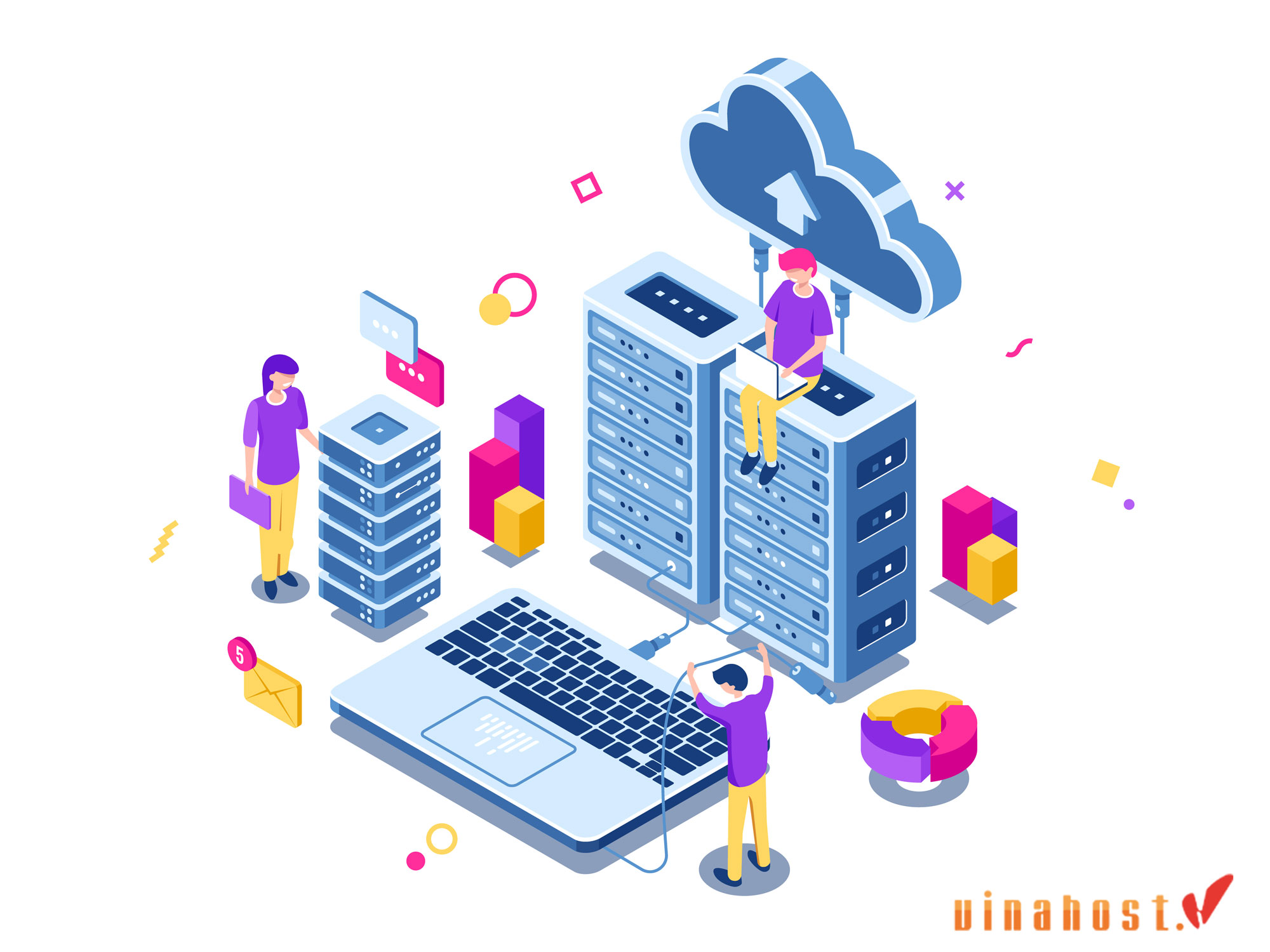
5. Benefits of Cloud Servers
Cloud servers offer a plethora of benefits, making them a popular choice for businesses and organizations of all sizes. Here are some key advantages:
- Scalability: Cloud servers provide the ability to quickly scale resources up or down based on demand. This elasticity allows businesses to handle fluctuations in traffic or workload without experiencing downtime or performance issues. Whether you need to accommodate a sudden spike in traffic or scale down during periods of low activity, cloud servers offer the flexibility to adjust resources accordingly.
- Cost-effectiveness: Cloud servers operate on a pay-as-you-go pricing model, where businesses only pay for the resources they consume. This eliminates the need for upfront capital investment in hardware and allows organizations to align their infrastructure costs with actual usage. Additionally, cloud servers eliminate the expenses associated with maintaining and managing on-premises hardware, such as electricity, cooling, and hardware maintenance.
- Reliability and Availability: Cloud servers are typically hosted in redundant data centers with high levels of availability and fault tolerance. This ensures that applications and services hosted on cloud servers remain accessible and reliable, even in the event of hardware failures or disasters. Cloud providers often offer service-level agreements (SLAs) guaranteeing uptime and performance, providing businesses with peace of mind knowing that their infrastructure is backed by robust reliability measures.
- Flexibility and Agility: Cloud servers offer unparalleled flexibility in terms of deployment options, operating systems, and configurations. Organizations can rapidly provision and configure cloud servers using web-based interfaces or APIs, allowing them to deploy new applications or services quickly and efficiently. Additionally, cloud servers support agile development practices, enabling organizations to innovate and iterate rapidly in response to changing market demands.
- Global Reach: Cloud servers enable businesses to deploy their applications and services closer to their target audience by leveraging the cloud provider’s global network of data centers. This distributed infrastructure reduces latency and improves performance for end-users worldwide, leading to a better user experience. Additionally, cloud servers facilitate geographic redundancy, ensuring that businesses can maintain operations even in the event of regional outages or disruptions.
- Security: Cloud servers offer robust security features and compliance certifications to protect data and applications hosted in the cloud. Cloud providers invest heavily in security measures, such as encryption, access controls, network security, and threat detection, to safeguard against cyber threats and unauthorized access. Additionally, cloud providers undergo regular security audits and compliance assessments to ensure that their infrastructure meets industry standards and regulatory requirements.
- Disaster Recovery and Backup: Cloud servers provide built-in disaster recovery and backup capabilities, allowing organizations to replicate critical data and workloads to remote data centers for redundancy and data protection. Cloud-based disaster recovery solutions offer faster recovery times and lower costs compared to traditional backup and recovery methods, ensuring business continuity in the event of hardware failures, natural disasters, or cyber attacks.
Cloud servers offer a wide range of benefits, including scalability, cost-effectiveness, reliability, flexibility, security, and disaster recovery capabilities. By leveraging cloud servers, businesses can innovate faster, reduce IT infrastructure costs, and focus on their core business objectives, driving growth and competitiveness in today’s digital economy.
Also Read: Maximizing Efficiency and Performance: What is Blade Server?
6. Choosing a Cloud Server Provider
Choosing the right cloud server provider is crucial for the success of your business or organization. Here are some key factors to consider when evaluating and selecting a cloud server provider:
- Performance and Reliability: Look for a cloud provider that offers high-performance infrastructure with reliable uptime and availability. Consider factors such as data center locations, network connectivity, hardware reliability, and SLA guarantees for uptime and performance.
- Scalability and Flexibility: Choose a cloud provider that offers scalable resources and flexible pricing options to accommodate your current and future needs. Ensure that the provider offers the ability to easily scale up or down resources such as compute, storage, and networking based on demand.
- Cost-effectiveness: Evaluate the pricing structure of the cloud provider to ensure it aligns with your budget and cost considerations. Compare pricing models, such as pay-as-you-go, subscription-based, or reserved instances, and consider factors such as compute hours, storage usage, data transfer costs, and additional services fees.
- Security and Compliance: Prioritize security and compliance features offered by the cloud provider to protect your data and applications. Look for features such as encryption, access controls, network security, threat detection, compliance certifications, and regulatory compliance tools to ensure that your infrastructure meets industry standards and regulatory requirements.
- Service Offerings: Assess the range of services and solutions offered by the cloud provider to meet your specific requirements. Consider factors such as compute instances, storage options, networking services, databases, analytics tools, machine learning, IoT platforms, and developer tools to support your workload and use cases.
- Management and Monitoring: Evaluate the management and monitoring tools provided by the cloud provider to simplify the deployment, management, and monitoring of your cloud infrastructure. Look for features such as centralized management consoles, automation tools, monitoring dashboards, and APIs for integration with existing systems and workflows.
- Support and SLAs: Consider the level of support and SLAs offered by the cloud provider to ensure prompt assistance and resolution of issues. Look for 24/7 customer support, dedicated account managers, documentation, community forums, and service-level agreements (SLAs) for uptime, performance, and support response times.
- Ecosystem and Integration: Assess the ecosystem and integration capabilities of the cloud provider to ensure compatibility with your existing systems, applications, and workflows. Look for partnerships, integrations, APIs, and ecosystem services that enable seamless integration with third-party tools, platforms, and services.
- Geographic Presence and Compliance: Consider the geographic presence of the cloud provider and its compliance with data residency and sovereignty regulations. Ensure that the provider offers data centers in regions that align with your data residency requirements and compliance obligations, such as GDPR, HIPAA, or SOC 2.
- Reputation and Reviews: Research the reputation and reviews of the cloud provider from existing customers, industry analysts, and independent review sites. Look for testimonials, case studies, customer satisfaction scores, and performance benchmarks to gauge the provider’s track record and customer satisfaction.
By carefully evaluating these factors and conducting thorough research, you can choose a cloud server provider that best meets your business needs, budget, and technical requirements, enabling you to leverage cloud computing effectively to drive innovation, growth, and success.
Cloud Server Standard | Free IPv6 – 24/7 support | 99% uptime | Just 8$
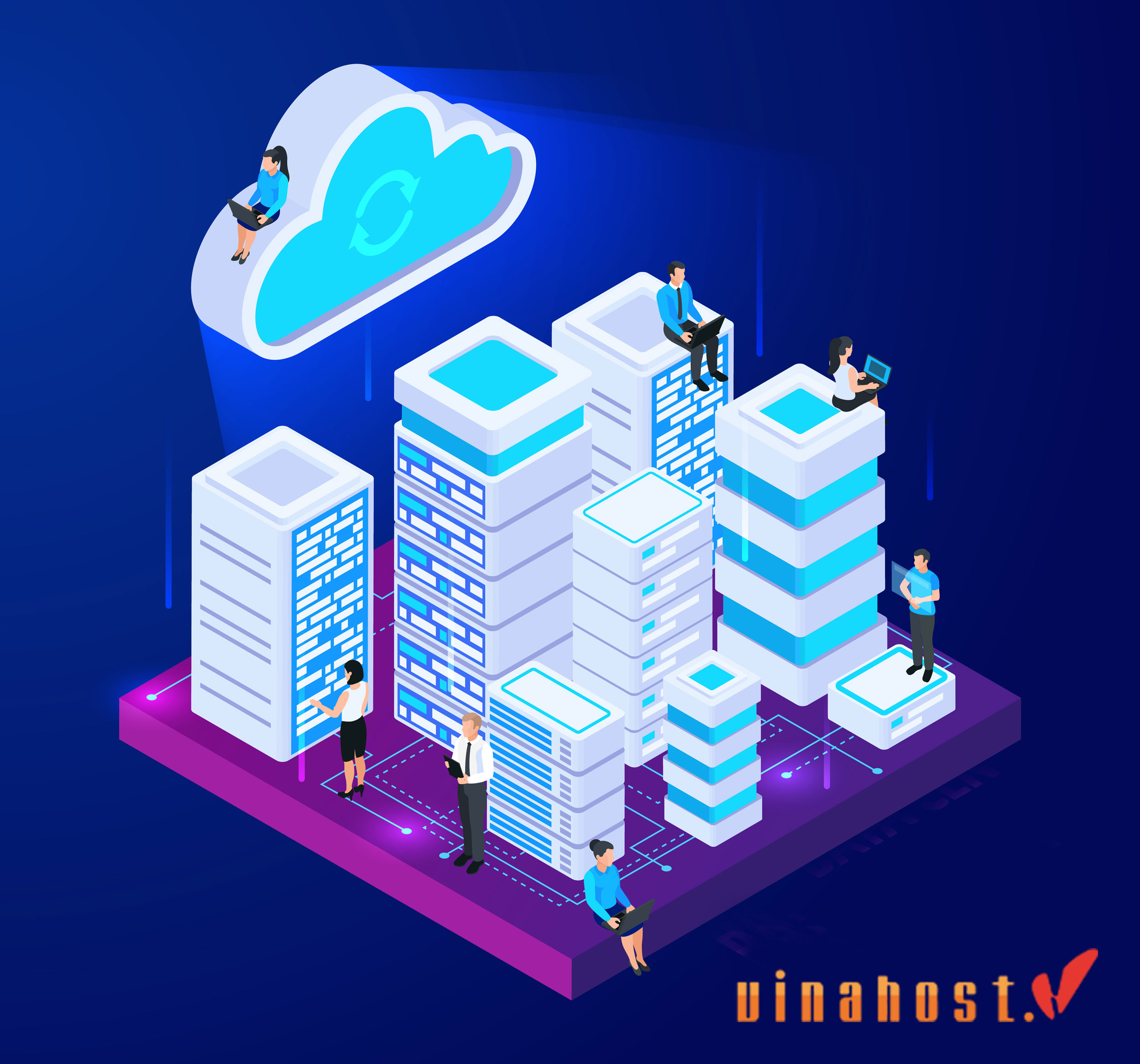
7. Future Trends in Cloud Server Technology
Several trends are shaping the future of cloud server technology, revolutionizing how businesses leverage cloud computing resources. Here are some key future trends in cloud server technology:
- Edge Computing: Edge computing brings computational power closer to the source of data generation, reducing latency and improving real-time responsiveness for applications and services. Cloud providers are investing in edge computing infrastructure, enabling organizations to process and analyze data at the edge of the network, closer to IoT devices, sensors, and end-users. This trend is driven by the proliferation of IoT devices, autonomous vehicles, augmented reality (AR), and other latency-sensitive applications that require rapid data processing and decision-making.
- Serverless Computing: Serverless computing, also known as Function as a Service (FaaS), abstracts away the underlying infrastructure management and allows developers to focus on writing code in the form of functions or microservices. Cloud providers handle the provisioning, scaling, and management of servers, enabling developers to deploy code without worrying about server maintenance or capacity planning. Serverless computing offers benefits such as reduced operational overhead, improved scalability, and cost optimization, making it an attractive option for modern application development and deployment.
- Hybrid and Multi-Cloud Architectures: Organizations are increasingly adopting hybrid and multi-cloud architectures to leverage the benefits of both public and private cloud environments. Hybrid cloud solutions allow organizations to seamlessly integrate on-premises infrastructure with public cloud services, providing flexibility, scalability, and data sovereignty benefits. Multi-cloud strategies involve using multiple cloud providers for different workloads or services to avoid vendor lock-in, improve resilience, and optimize costs. Cloud providers are expanding their offerings to support hybrid and multi-cloud deployments, including tools for workload migration, orchestration, and management across diverse cloud environments.
- Containerization and Kubernetes: Containerization technologies such as Docker and container orchestration platforms like Kubernetes are becoming fundamental building blocks for cloud-native application development and deployment. Containers offer lightweight, portable, and isolated runtime environments that enable developers to package applications and dependencies consistently across different environments. Kubernetes provides automation and management capabilities for deploying, scaling, and managing containerized applications in production environments. Cloud providers are offering managed Kubernetes services and container registries to simplify container orchestration and accelerate application delivery.
- AI and Machine Learning Services: Cloud providers are investing in artificial intelligence (AI) and machine learning (ML) services to democratize AI capabilities and enable organizations to build intelligent applications and services. Cloud-based AI and ML services provide pre-trained models, APIs, and tools for tasks such as natural language processing, image recognition, speech recognition, and predictive analytics. These services empower developers to incorporate AI and ML functionality into their applications without requiring specialized expertise in AI algorithms or infrastructure.
- Serverless Databases: Serverless databases, also known as Database as a Service (DBaaS), offer fully managed database solutions that scale dynamically based on workload demand. Cloud providers are offering serverless database services that automatically provision, scale, and manage databases, eliminating the need for manual capacity planning or database administration. Serverless databases offer benefits such as automatic scaling, pay-as-you-go pricing, built-in high availability, and automated backups, making them well-suited for modern cloud-native applications.
- Green Cloud Computing: As environmental concerns become increasingly important, cloud providers are prioritizing sustainability and energy efficiency in their data center operations. Green cloud computing initiatives involve optimizing data center design, infrastructure efficiency, renewable energy usage, and carbon footprint reduction strategies. Cloud providers are investing in renewable energy sources, energy-efficient hardware, and innovative cooling technologies to minimize the environmental impact of cloud computing while delivering sustainable and eco-friendly cloud services.
These future trends in cloud server technology are driving innovation, agility, and efficiency in the cloud computing industry, enabling organizations to accelerate digital transformation, drive business growth, and unlock new opportunities in the evolving digital landscape.
Also Read: What is a Dedicated Server? | How Does a Dedicated Server Work?
8. FAQs
8.1. Can I switch between different cloud server providers easily?
Switching between different cloud server providers can be challenging, but it’s certainly feasible with careful planning and execution. Here are some key considerations to keep in mind when transitioning between cloud providers:
- Compatibility and Interoperability: Before migrating workloads or data to a new cloud provider, ensure compatibility and interoperability between the current and target environments. Evaluate the differences in infrastructure, services, APIs, and management tools to identify any potential compatibility issues or dependencies that may impact the migration process.
- Data Migration: Plan and execute a data migration strategy to transfer data from the current cloud provider to the new provider. Depending on the volume and complexity of the data, migration methods may include direct transfers over the internet, offline data transfer services, or third-party migration tools. Ensure data integrity, security, and compliance throughout the migration process to minimize the risk of data loss or corruption.
- Application Re-Architecture: Assess the architecture of your applications and services to identify any dependencies or configurations that are specific to the current cloud provider. Modify or re-architect applications as needed to ensure compatibility with the target cloud environment. Consider leveraging containerization technologies such as Docker and Kubernetes to containerize applications for easier portability across different cloud providers.
- Network Connectivity: Establish network connectivity between your current and target cloud environments to facilitate data transfer, application communication, and workload migration. Set up virtual private network (VPN) connections, direct interconnects, or peering arrangements between the networks to ensure secure and reliable connectivity between cloud providers.
- Identity and Access Management: Implement identity and access management (IAM) policies and controls to manage user access and permissions across different cloud providers. Ensure consistent authentication mechanisms, role-based access controls, and auditing capabilities to maintain security and compliance when switching between cloud providers.
- Testing and Validation: Conduct thorough testing and validation of migrated workloads, applications, and data in the target cloud environment to ensure functionality, performance, and reliability. Test various scenarios, such as workload scaling, failover, and disaster recovery, to verify that the new environment meets your requirements and expectations.
- Cost Analysis: Evaluate the cost implications of switching between cloud providers, including factors such as pricing models, resource usage, data transfer fees, and additional services. Compare the total cost of ownership (TCO) between the current and target cloud environments to ensure cost-effectiveness and budget alignment.
- Vendor Lock-In Mitigation: Implement strategies to mitigate vendor lock-in when switching between cloud providers. Choose cloud-agnostic services and architectures whenever possible to minimize dependencies on specific cloud provider features or APIs. Leverage industry standards, open-source technologies, and multi-cloud management tools to maintain flexibility and portability across different cloud environments.
Switching between cloud server providers requires careful planning, thorough preparation, and meticulous execution to ensure a smooth and successful transition. By addressing key considerations such as compatibility, data migration, application re-architecture, network connectivity, security, testing, cost analysis, and vendor lock-in mitigation, organizations can effectively switch between cloud providers and unlock the benefits of multi-cloud environments.
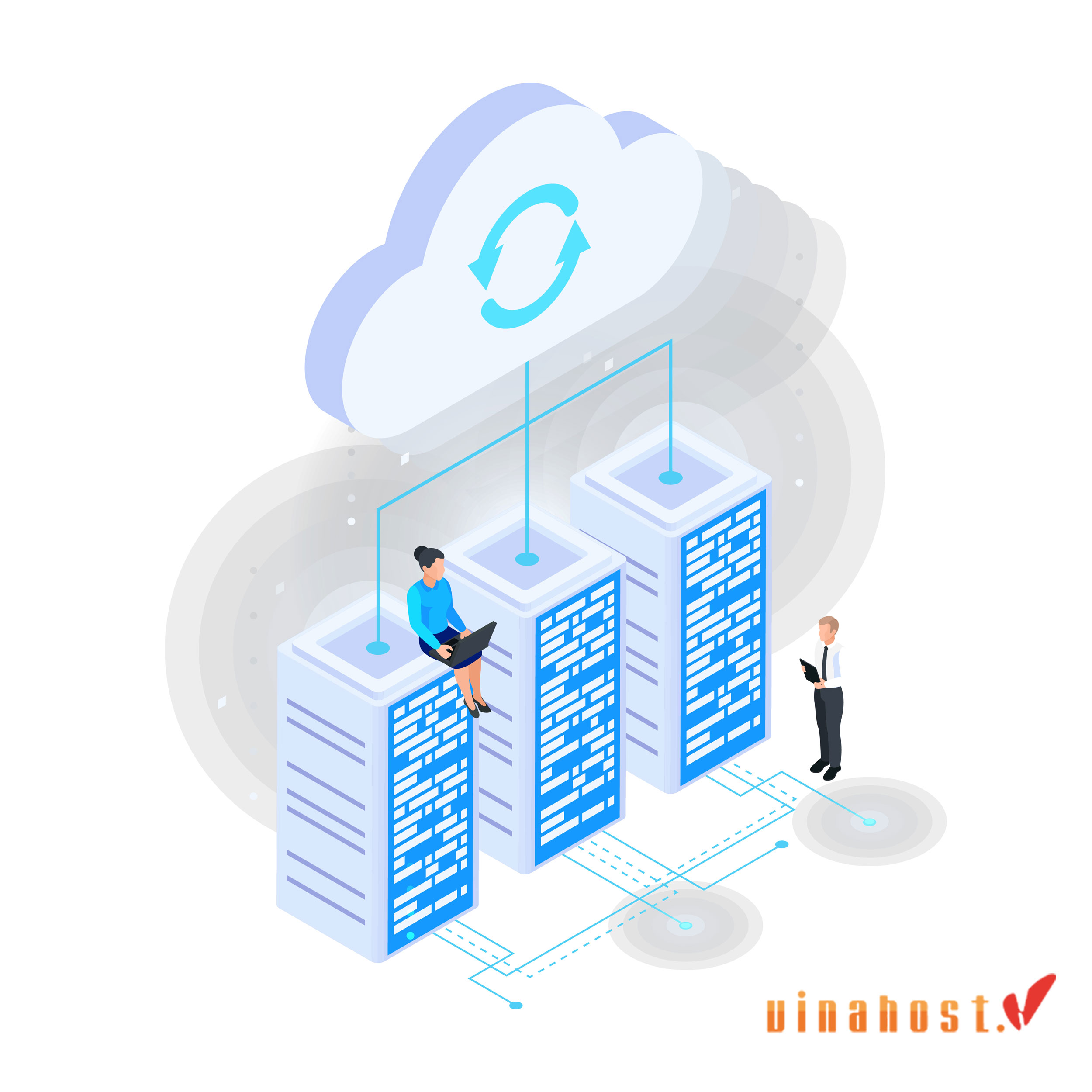
8.2. How secure are cloud servers?
Cloud servers can be highly secure when implemented and managed properly, but their security depends on various factors, including the cloud provider’s infrastructure, security measures, and best practices followed by users. Here are some key aspects of cloud server security:
- Physical Security: Cloud providers implement robust physical security measures to protect their data centers, including access controls, surveillance cameras, biometric authentication, and perimeter fencing. Data centers are often equipped with redundant power supplies, fire suppression systems, and environmental controls to ensure uptime and reliability.
- Network Security: Cloud providers employ network security measures to protect data in transit between users and cloud servers. This includes encryption protocols such as Transport Layer Security (TLS) and Virtual Private Networks (VPNs) to secure network communications and prevent eavesdropping or interception by unauthorized parties.
- Data Encryption: Cloud providers offer encryption mechanisms to protect data at rest stored on cloud servers. Encryption keys are managed securely, and data is encrypted using strong cryptographic algorithms to prevent unauthorized access or data breaches. Customers can also implement client-side encryption to encrypt data before uploading it to the cloud.
- Identity and Access Management (IAM): Cloud providers offer IAM services to manage user access and permissions to cloud resources. This includes features such as multi-factor authentication (MFA), role-based access control (RBAC), fine-grained access policies, and auditing capabilities to enforce security policies and monitor user activities.
- Security Compliance: Cloud providers adhere to industry-standard security certifications and compliance frameworks to ensure the security and privacy of customer data. This includes certifications such as ISO 27001, SOC 2, HIPAA, GDPR, and PCI DSS, as well as compliance with regulatory requirements specific to certain industries or regions.
- Security Monitoring and Incident Response: Cloud providers implement security monitoring and incident response mechanisms to detect, investigate, and mitigate security threats and incidents. This includes intrusion detection systems (IDS), security information and event management (SIEM) tools, automated threat detection algorithms, and 24/7 security operations centers (SOC) staffed by security experts.
- Backup and Disaster Recovery: Cloud providers offer backup and disaster recovery services to protect against data loss and ensure business continuity in the event of hardware failures, natural disasters, or cyber attacks. This includes automated backups, data replication across multiple data centers, and failover mechanisms to restore services quickly in case of disruptions.
While cloud servers offer robust security features and protections, it’s essential for users to follow security best practices and implement additional security controls to safeguard their data and applications in the cloud. This includes practices such as strong password management, regular security updates and patches, network segmentation, data classification, encryption key management, and employee security awareness training.
By combining the security measures provided by cloud providers with proactive security measures and best practices, organizations can enhance the security of their cloud servers and mitigate potential security risks effectively.
8.3. Can cloud servers handle high traffic volumes?
Yes, cloud servers are designed to handle high traffic volumes effectively. Cloud servers offer scalability and flexibility, allowing resources such as CPU, memory, storage, and network bandwidth to be dynamically scaled up or down based on demand. This elasticity enables cloud servers to accommodate fluctuations in traffic volumes without experiencing performance degradation or downtime.
Cloud providers offer various scaling mechanisms to handle high traffic volumes efficiently:
- Vertical Scaling: Cloud servers can be vertically scaled by increasing the resources allocated to them, such as upgrading to a higher-tier instance with more CPU cores, memory, or storage capacity. This allows organizations to handle increased traffic loads by provisioning more powerful server instances to support higher workloads.
- Horizontal Scaling: Cloud servers can be horizontally scaled by adding more instances to distribute the workload across multiple servers. This approach, often referred to as auto-scaling or horizontal scaling, allows organizations to handle spikes in traffic by adding additional server instances dynamically and removing them when traffic decreases.
- Load Balancing: Cloud providers offer load balancing services that distribute incoming traffic across multiple server instances to optimize performance and availability. Load balancers monitor server health and traffic patterns, automatically routing requests to the most available and least loaded servers to ensure efficient resource utilization and prevent overloading.
- Content Delivery Networks (CDNs): Cloud providers offer content delivery networks (CDNs) that cache and distribute content across a global network of edge servers closer to end-users. CDNs accelerate content delivery, reduce latency, and offload traffic from origin servers, making them an effective solution for handling high traffic volumes, especially for static content such as images, videos, and web assets.
- Serverless Computing: Serverless computing platforms, such as AWS Lambda, Azure Functions, and Google Cloud Functions, offer event-driven computing services that automatically scale resources based on incoming requests or events. This serverless architecture eliminates the need for provisioning and managing servers, allowing organizations to focus on writing code while the cloud provider handles scaling and resource management.
Cloud servers are well-suited for handling high traffic volumes due to their scalability, flexibility, load balancing capabilities, and support for horizontal and vertical scaling. By leveraging these features and best practices, organizations can ensure that their cloud servers can effectively handle spikes in traffic and provide reliable performance and availability to end-users.
8.4. Are cloud servers suitable for small businesses?
Yes, cloud servers are highly suitable for small businesses, offering numerous benefits that can help them improve efficiency, reduce costs, and compete more effectively in today’s digital landscape. Here are some reasons why cloud servers are advantageous for small businesses:
- Cost-Effectiveness: Cloud servers operate on a pay-as-you-go or subscription-based pricing model, allowing small businesses to access computing resources without the need for significant upfront investment in hardware or infrastructure. This cost-effective pricing model enables small businesses to scale resources up or down based on demand and only pay for the resources they consume, reducing overall IT costs.
- Scalability and Flexibility: Cloud servers offer scalability and flexibility, allowing small businesses to easily scale resources up or down based on changing requirements or growth. Whether it’s handling spikes in traffic, launching new services, or expanding into new markets, cloud servers enable small businesses to adapt quickly to evolving business needs without the constraints of traditional on-premises infrastructure.
- Accessibility and Mobility: Cloud servers provide remote access to computing resources over the internet, enabling small businesses to access their applications, data, and services from anywhere, at any time, and on any device. This accessibility and mobility empower employees to work remotely, collaborate effectively, and stay productive, regardless of their location or device.
- Reliability and Uptime: Cloud providers operate redundant data centers with high levels of availability and uptime, ensuring that small businesses can rely on their cloud servers to provide consistent access to applications and services. Cloud servers offer built-in redundancy, failover mechanisms, and disaster recovery capabilities to minimize downtime and maintain business continuity in the event of hardware failures or disruptions.
- Security and Compliance: Cloud providers invest heavily in security measures to protect their infrastructure and customer data, offering robust security features such as encryption, access controls, network security, and compliance certifications. By leveraging cloud servers, small businesses can benefit from enterprise-grade security controls and ensure compliance with industry regulations and data protection standards without the need for dedicated security expertise or resources.
- Focus on Core Business: Cloud servers offload the burden of managing hardware, infrastructure, and maintenance tasks to the cloud provider, allowing small businesses to focus on their core business activities and strategic initiatives. With cloud servers, small businesses can avoid the complexities of managing on-premises infrastructure and IT operations and instead allocate resources to business-critical projects and innovation.
Cloud servers offer small businesses a cost-effective, scalable, accessible, and secure computing platform that enables them to compete more effectively, innovate faster, and drive growth in today’s digital economy. By leveraging cloud servers, small businesses can access enterprise-grade technology and resources without the need for significant upfront investment, empowering them to succeed and thrive in a competitive marketplace.
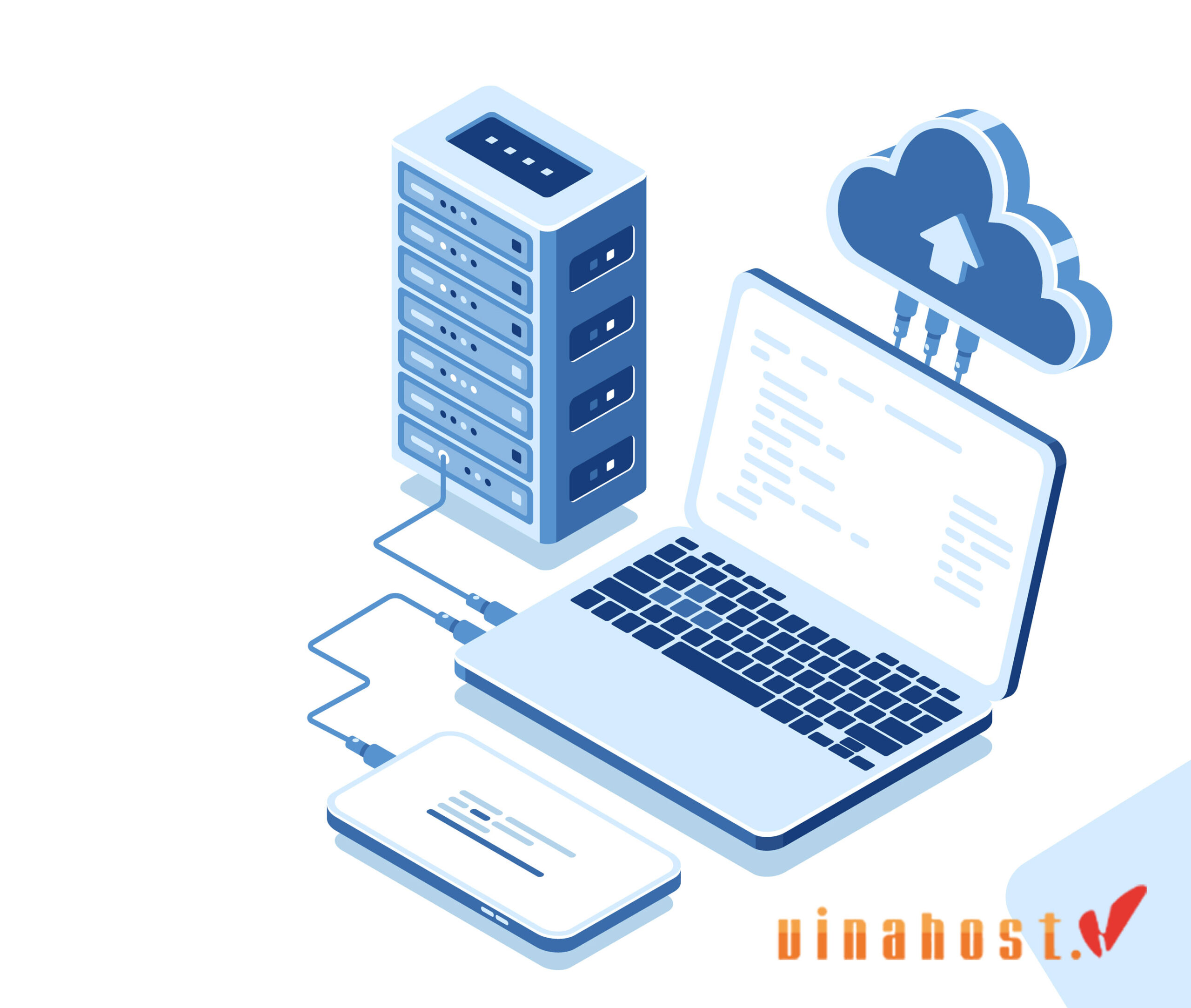
8.5. Can cloud servers be used for machine learning tasks?
Yes, cloud servers can be effectively used for machine learning (ML) tasks, providing scalable infrastructure, powerful computing resources, and a wide range of ML tools and services. Here are several ways in which cloud servers support ML tasks:
- High-Performance Computing (HPC) Instances: Cloud providers offer specialized virtual machine instances optimized for high-performance computing tasks, including ML workloads. These instances typically feature powerful CPUs, GPUs, or specialized accelerators such as TPUs (Tensor Processing Units) to accelerate ML model training and inference tasks.
- Managed ML Services: Cloud providers offer managed ML services that abstract away the complexity of infrastructure management and provide pre-built ML models, algorithms, and APIs for common use cases such as image recognition, natural language processing (NLP), speech recognition, and predictive analytics. Examples include AWS SageMaker, Google Cloud AI Platform, and Azure Machine Learning.
- Custom ML Environments: Cloud servers allow users to create custom ML environments tailored to their specific requirements, including choice of programming languages, frameworks, libraries, and development tools. Users can leverage containerization technologies such as Docker and Kubernetes to create reproducible ML environments and deploy them on cloud servers.
- Data Processing and Storage: Cloud servers offer scalable data processing and storage services that support ML workflows, including data ingestion, preprocessing, transformation, and analysis. Cloud storage services such as Amazon S3, Google Cloud Storage, and Azure Blob Storage provide durable and scalable storage solutions for large datasets used in ML training and experimentation.
- Parallel Computing and Distributed Training: Cloud servers enable parallel computing and distributed training of ML models across multiple server instances, allowing users to accelerate model training and handle large datasets efficiently. Cloud providers offer frameworks and tools for distributed computing, such as Apache Spark, TensorFlow Distributed, and PyTorch Distributed, that leverage cloud infrastructure to scale ML workloads horizontally.
- Model Deployment and Serving: Cloud servers support the deployment and serving of ML models in production environments, allowing users to deploy trained models as scalable and resilient web services or APIs. Cloud providers offer model deployment platforms, such as AWS Lambda, Google Cloud Functions, and Azure Functions, that enable serverless deployment and auto-scaling of ML inference endpoints.
- AutoML and Hyperparameter Tuning: Cloud providers offer AutoML (Automated Machine Learning) services that automate the process of model selection, feature engineering, and hyperparameter tuning, allowing users to build ML models with minimal manual intervention. AutoML platforms leverage cloud infrastructure and scalable computing resources to train and optimize ML models efficiently.
Cloud servers provide a flexible and scalable platform for conducting a wide range of machine learning tasks, from data preprocessing and model training to deployment and inference. By leveraging cloud servers and ML services, organizations can accelerate ML development, reduce time-to-market, and unlock valuable insights from their data, driving innovation and competitiveness in today’s data-driven world.
8.6. Can I access my cloud server from anywhere?
Yes, you can access your cloud server from anywhere with an internet connection. Cloud servers are designed to be accessible remotely, allowing users to connect to them from any location, at any time, and from any device. Here are several ways you can access your cloud server:
- Remote Desktop Protocol (RDP): For Windows-based cloud servers, you can use Remote Desktop Protocol (RDP) to establish a remote desktop connection from your local computer to the cloud server. RDP provides a graphical user interface (GUI) for interacting with the server’s desktop environment, allowing you to access files, applications, and resources as if you were physically sitting at the server.
- Secure Shell (SSH): For Linux-based cloud servers, you can use Secure Shell (SSH) to establish a secure command-line connection from your local computer to the server. SSH provides a text-based interface for executing commands and managing the server remotely, including tasks such as file management, software installation, configuration, and troubleshooting.
- Web-based Console: Most cloud providers offer a web-based management console or dashboard that allows you to access and manage your cloud servers through a web browser. The management console provides a user-friendly interface for performing common administrative tasks, monitoring server health and performance, and accessing cloud services and resources.
- Remote Access Tools: Some cloud providers offer remote access tools or client applications that streamline the process of connecting to cloud servers from desktop or mobile devices. These tools may provide additional features such as file transfer, session recording, multi-factor authentication (MFA), and session management for enhanced security and convenience.
- Virtual Private Network (VPN): If you prefer to access your cloud server securely over the internet, you can set up a virtual private network (VPN) connection between your local network and the cloud server. A VPN creates an encrypted tunnel that protects data in transit and allows you to access resources on the cloud server as if they were on your local network.
- APIs and SDKs: Cloud providers offer application programming interfaces (APIs) and software development kits (SDKs) that allow developers to programmatically interact with cloud servers and automate management tasks. By integrating cloud APIs and SDKs into custom applications or scripts, you can access and manage cloud servers programmatically from anywhere.
Cloud servers offer remote accessibility and flexibility, enabling users to access, manage, and interact with their servers from anywhere with an internet connection. Whether you prefer a graphical interface, command-line access, or programmable automation, cloud servers provide the tools and capabilities to meet your remote access needs effectively.
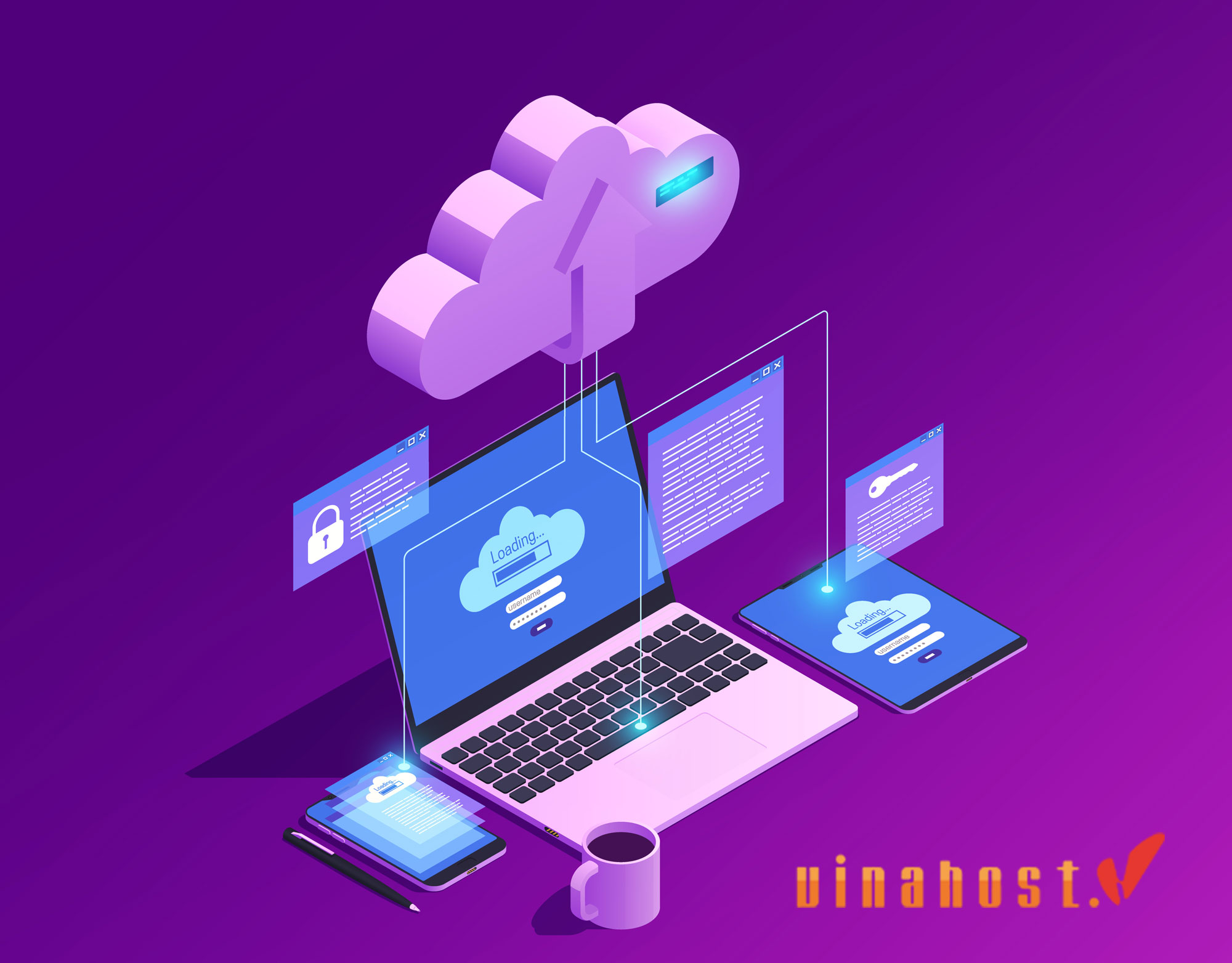
8.7. What is the difference between cloud server and traditional server?
Cloud servers and traditional servers differ in several key aspects, including infrastructure, deployment model, scalability, management, and cost structure. Here’s a comparison between cloud servers and traditional servers:
Infrastructure
- Cloud Server: Cloud servers are hosted on virtualized infrastructure provided by a cloud service provider. They run on shared physical hardware in data centers, with resources such as CPU, memory, and storage dynamically allocated from a pool of available resources.
- Traditional Server: Traditional servers are physical machines deployed on-premises or in dedicated data centers owned and managed by the organization. Each server typically runs a single operating system and hosts applications and services.
Deployment Model
- Cloud Server: Cloud servers are deployed and managed remotely by the cloud service provider. Users access cloud servers over the internet and can provision, scale, and manage them using web-based interfaces or APIs.
- Traditional Server: Traditional servers are deployed and managed locally by the organization’s IT staff. Users physically access the servers to install, configure, and maintain hardware, operating systems, and applications.
Scalability
- Cloud Server: Cloud servers offer scalability, allowing users to dynamically scale resources up or down based on demand. Users can provision additional resources or resize server instances as needed, enabling flexible and cost-effective resource management.
- Traditional Server: Traditional servers have limited scalability and require upfront capacity planning and hardware provisioning. Scaling traditional servers typically involves purchasing and installing additional hardware, which can be time-consuming and costly.
Management
- Cloud Server: Cloud servers are managed by the cloud service provider, who is responsible for infrastructure maintenance, security, updates, and support. Users are responsible for managing their applications, data, and configurations within the cloud server.
- Traditional Server: Traditional servers are managed internally by the organization’s IT staff, who are responsible for hardware maintenance, operating system updates, security patches, backups, and troubleshooting.
Cost Structure
- Cloud Server: Cloud servers operate on a pay-as-you-go or subscription-based pricing model, where users pay for the resources they consume on a usage basis. Costs are typically based on factors such as compute hours, storage usage, data transfer, and additional services.
- Traditional Server: Traditional servers involve upfront capital expenses for purchasing hardware, software licenses, and infrastructure components. Costs also include ongoing expenses for maintenance, power, cooling, and facility space.
Reliability and Availability
- Cloud Server: Cloud servers offer high levels of reliability and availability, with redundant infrastructure, automatic failover mechanisms, and data replication across multiple data centers. Cloud providers offer service-level agreements (SLAs) guaranteeing uptime and performance.
- Traditional Server: Traditional servers rely on the reliability of on-premises infrastructure and may lack the redundancy and fault tolerance of cloud environments. Ensuring high availability often requires implementing redundant hardware, backup systems, and disaster recovery solutions.
While both cloud servers and traditional servers serve the same purpose of hosting applications and services, they differ significantly in terms of infrastructure, deployment model, scalability, management, cost structure, and reliability. The choice between cloud servers and traditional servers depends on factors such as workload requirements, budget constraints, scalability needs, and IT preferences.
9. Conclusion
What is a Cloud Server? A cloud server is a virtualized computing resource offered by cloud service providers, delivering flexible and scalable infrastructure over the internet. Unlike traditional servers, cloud servers are deployed and managed remotely, providing users with on-demand access to compute, storage, and networking resources without the need for upfront hardware investment or physical infrastructure maintenance.
Cloud servers offer numerous benefits, including scalability, cost-effectiveness, accessibility, reliability, and security, making them an ideal choice for businesses and organizations of all sizes seeking to leverage the power of cloud computing.
As technology continues to evolve, cloud servers are expected to play an increasingly pivotal role in driving innovation, enabling digital transformation, and empowering organizations to thrive in today’s dynamic and competitive landscape.
You can see more articles from VinaHost HERE or contact us if you need advice on services:
- Email: support@vinahost.vn
- Hotline: 1900 6046
- Livechat: https://livechat.vinahost.vn/chat.php
Also Read:
What is Mail Server? | The Importance of Mail Servers
What is a Web Server & How Web Servers Work?


 Tiếng Việt
Tiếng Việt English
English 简体中文
简体中文





























